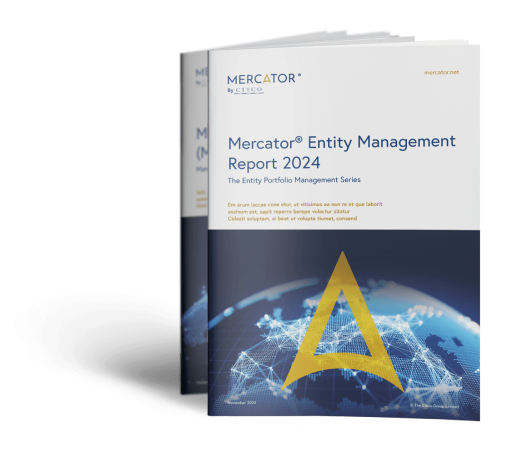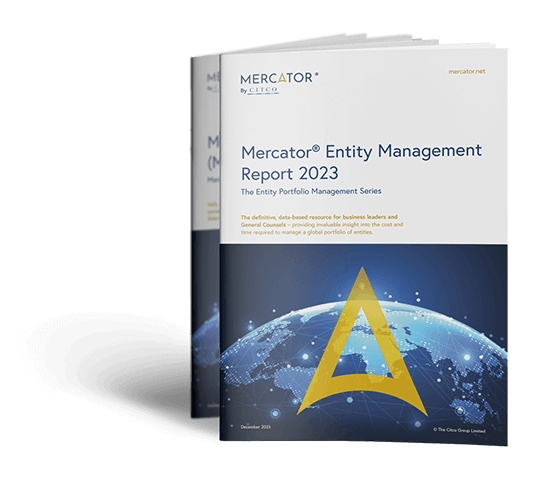The information contained in this document is marketing material and for informational purposes only. The information contained in this document is presented without any warranty or representation as to its accuracy or completeness and all implied representations or warranties of any kind are hereby disclaimed. Recipients of this document, whether clients or otherwise, should not act or refrain from acting on the basis of any information included in this document without seeking appropriate professional advice. The provision of the information contained in this document does not establish any express or implied duty or obligation between Citco and any recipient and neither Citco nor any of its shareholders, members, directors, principals or personnel shall be responsible or liable for results arising from the use or reliance of the information contained in this document including, without limitation, any loss (whether direct, indirect, in contract, tort or otherwise) arising from any decision made or action taken by any party in reliance upon the information contained in this document. © The Citco Group Limited, December 2024.
A Complex Route
In a recent article for Governance & Compliance Magazine, Kariem Abdellatif, Head of Mercator, discusses key findings from the Mercator Entity Management Report 2021.
There are several regional and jurisdictional dynamics in the entity portfolio management industry
As a truly global industry, the pandemic brought unique challenges for governance professionals responsible for Global Entity Portfolio Management (GEPM)- an industry already faced with navigating an increasingly complex global regulatory environment. While the future of working models appears to gaining more clarity, with workers gradually returning to the office in a new hybrid model, the latter persists. Negotiating this rising complexity continues to put pressure on the business leaders, General Counsels and corporate secretarial teams of multinationals to innovate and optimise their governance processes across their portfolio of entities.
The value of clear, data-driven insights and performance metrics is increasingly prevalent across many industries, yet for General Counsels in particular, there remains the challenge of accessing such data- data that can demonstrate to internal stakeholders that they are performing optimally, in comparison to both their peers and the industry as a whole. This also stems from the fact that GEPM is only now being considered an industry in its own right, where past data tended to be derived from a patchwork of internal and external sources, and limited by a lack of standardization. Additionally, industry-wide datasets have typically been survey-driven, and thus rarely provide a truly accurate, comprehensive, and objective picture of the global governance landscape.
To challenge this, the Mercator Entity Management (MEM) report provides specific insights on the overseas entities of multinational companies, measuring regional and jurisdictional distribution of activities, duration for completing activities, and relative cost. In doing so, we have considered Event-Driven activities which occur frequently and which are initiated by our clients, rather than Annual Obligations that are statutory requirements. Here are the key findings.
Where we see the most Company Entities?
In providing an overview of the GEPM landscape is important to understand where exactly these entities are based. The complexity of a region in terms of event-driven activities is dependent on a cross-section of variables. The volume of activities is influenced by the type of business, local/country requirements, and size/ activity-level of the entity. If the subsidiary contains a large number of employees, the activity level is likely to be high. Activities in service-sector oriented countries tend to concentrate in certain cities, thereby increasing efficiency, while manufacturing oriented countries tend to be more dispersed.
Taking a regional overview, our database has the highest relative proportion of entities per region in Europe (49%), followed by Asia-Pacific (APAC) (25%), Latin America (LATAM) (11%), Middle East and Africa (MEA) (7.5%) and North America (NA) (7.5%).
However, when cross-analysing the average number of activities per region with the average number of activities per entity, the activity per entity for Europe is comparable to MEA and NA. APAC has about two-thirds of the number of entities in Europe, but has 50% more activities per entity on average.
This increased level of activity per entity in APAC is due to the higher number of filings with regulatory authorities and updates to internal registers required in the region, especially where local company secretaries should be mandatorily appointed. This dynamic becomes more apparent when looking at the weighted average number of activities per entity in each region. APAC leads with 6.4 activities per entity, followed by Europe with 4.5.
Overall, there are 20 different activity types included in the scope of this study, of which three activities – management/officer changes, Power of Attorney (PoA), and BoD/shareholder decisions collectively account for 35% of total activity. Taking a more granular look at the proportions of different tasks in different regions, you can understand how decision-making – specifically on granting authority – differs per region. For example, in Europe and LATAM, legal systems are mostly based on civil law and the use of PoA as an authorisation method is much more customary. In contrast, authorisation via a Board decision is much more customary in common law-influenced APAC jurisdictions. Additionally, boards are more widely used as a managerial tool in APAC, as opposed to directors being solely or jointly authorised, which has resulted in more Board resolutions in that region.
When looking at individual countries, Malaysia (13.8), India (12.7), Philippines (12.0), Singapore (11.5), and Macao (7.8) round out the top 5 for activities per entity. It is no coincidence that all five of these regions mandate the appointment of a local secretary to actively participate in entity governance, or that BoD decisions are required for the vast majority of business matters. Similar relationships between local context and activity levels are seen when looking at individual actions byjurisdictions. Standout findings here relate to Singapore, which leads for management/officer change activities per entity with 2.84, well ahead of Bangladesh, second with 1.67. This is likely a result of the simple fact that countries with larger boards are more naturally more likely to change directors. And again, the fact that the Philippines (3.8), Malaysia (2.85), India (2.06), and Singapore (1.83) round out the top 4 for average BoD decisions reasserts the aforementioned finding that APAC contains jurisdictions in which boards are more widely used as a management tool.
Understanding Duration
The second metric in this study, aims to provide a benchmark for governance professionals on how long it takes to complete specific activities in each region and jurisdiction assessed. Nuances in regulation can clearly vary greatly across the globe. Each entity’s specific organizational circumstances and adoption of technology can significantly affect the time it takes for activities to be completed. It is important to note that since our figures are based on 2020 and the first half of 2021, these insights are likely to reflect how jurisdictions have been affected by the global pandemic, as rules and conventions about the size of boards and the speed of processing documents and online filings are likely to have been impacted. Likewise, the particularities of businesses themselves will inevitably factor into the time it takes to complete tasks- internal organizational factors such as whether they have a centralized or decentralized business model, as well as their differing technological capabilities. Nevertheless, the data provides useful interesting insights.
APAC has the lowest overall event-driven activity duration, as well as completing management/officer changes the fastest. As a general principle, it appears that having a local resident as a manager/director or representative speeds up processes, particularly due to the related fact that local requirements are a central determinant of speed of execution. These requirements can act as red-tape that significantly constrains speed- for example, several countries, particularly in APAC, mandate notarized documents be on a specific size of paper, single-sided, signed precisely in black ink, and bound with a corporate seal ‘tally impression’ if over two pages long. Non-fulfilment of these stringent requirements can lead to rejection and resubmission, costing valuable time. But more positively, online filing systems can significantly expedite such processes, and the pandemic has expedited their deployment and adoption in several countries. Additional findings suggest that countries in which having a greater number of board directors is the norm are slower to complete board-decision activities, likely due to needing more individuals to sign off on decisions.
Cost of entity management
When setting up new entities in a corporate structure, knowledge about the costs likely to be incurred by such entities, and how these match up to other locations, is invaluable. However, any analysis of costs related to entity management activities must acknowledge the practical differences between jurisdictions, along with the availability of specialized providers, and the inevitable nuances specific to different types of corporate actors, both local and multinational. The study focuses on the latter, and their spread across and within various jurisdictions.
By region, APAC entities benefit from the cheapest average fees per event-driven activity, alongside being the cheapest specifically for both PoA activities and BoD decision activities- the latter it shares jointly with NA, who also have the lowest average fee when replacing a director.
These regional averages are affected by several factors. Naturally, the competitive landscape of the region has significant bearing- the supply of firms who offer the professional services required naturally influences their pricing. These fees are of course variable relative to the overall pricing norms and economy of the region, while the complexity of local legislation will bear on the time, skill, and subsequent cost needed to complete a task. Finally, whether a locality requires filings to be made in the local language will affect costs specifically for multinationals- for example, the relatively high prices per activity in LATAM (29% higher than APAC) are largely explained by higher local professional costs due to complexity and language requirements, incurring further costs when translations and legalizations for bilingual documents need to be arranged.
When considering cost, while there is a correlation between the duration of activities and pricing thereof, most clearly demonstrated by APAC, this obscures the diversity of the Asian jurisdictions. It contains within it, six of the most expansive jurisdictions (China, Taiwan, South Korea, Japan, & Indonesia), and six of the cheapest (Sri Lanka, Malaysia, Australia, Philippines, Singapore, and Hong Kong). This correlation between duration and price does not hold as strongly in LATAM regions, the region appearing to be more costly than one would expect on the basis of activity duration.
Singapore top of the charts
Overall, Singapore emerges as the most favourable overall location to base entities in 2020/’21, closely followed by Australia and the United Kingdom, all three reflecting the ideal combination between cost and duration, and representing established, respected financial centres with a long, proven history of managing international trade and business- cementing their ideal status.
In particular, Singapore is credited with a strong government response to the pandemic, further boosted from a business’s perspective by their robust availability of digital filing systems, and e-signature acceptance across the board. Legally, virtual shareholders’ and board meetings are permissible, while flexible working arrangements are established and accepted, mitigating the worldwide disruption caused by the pandemic.
Administratively, entities based here can benefit from, simple online processes for applying for deadline extensions, and, significantly, a document legalization process- ratifying the Hague Convention in January 2021.
At the other end of the spectrum, South Korea ranked the lowest based on cost and duration, followed by Indonesia and Kazakhstan. We must again reassert that the purpose of this report is not to advise multinationals on where and where not to base entities or subsidiaries, as this will of course be influenced by a combination of necessity and nuanced, individual factors. Instead, it is to provide the data needed to set expectations and provide foresight on the relative cost and time it will take to manage entities in each region and jurisdiction.
This article was originally published in the October issue of Governance & Compliance Magazine.

